Other common names
Little hogweed, pigweed, parsley, wild portulaca, etc.
Scientific name
Portulaca oleracea
Family
Portulacaceae
Description
Common purslane is a fleshy plant that grows in a low, spreading mat.
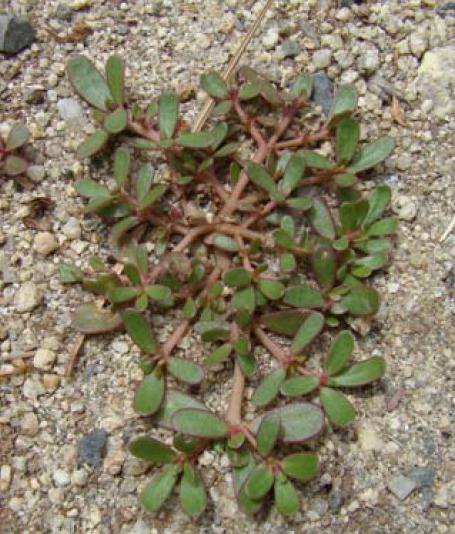
Typical plant growing in a garden. Photo by W. Hanson Mazet.
Leaves
Teardrop‐shaped leaves are smooth, fleshy and shiny, and may have red margins.
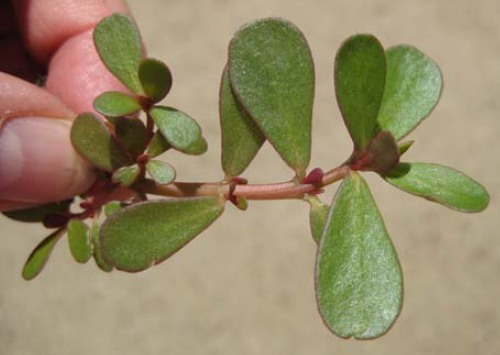
The leaves are fleshy and succulent, and the stems are pinkish. Photo by S. Donaldson.
Stems
Pinkish‐red and smooth. Stems radiate from the center of the plant.
Flowers
Tiny, yellow, with five petals. Occur where leaves join the stem. Flowers open only in the sun. Blooms from summer to fall.
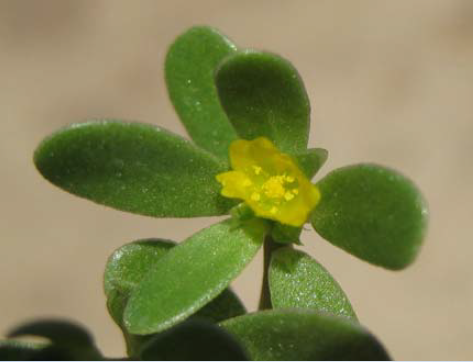
Flowers are tiny, yellow and open only in the sun. Photos by S. Donaldson.
Seeds
Tiny and black; can remain dormant in the soil for years.
Roots
Has a short taproot.
Native to
Europe; has naturalized in much of the United States.
Where it grows
Gardens, lawns, landscapes and other moist sites. It will also grow in cracks in the pavement.
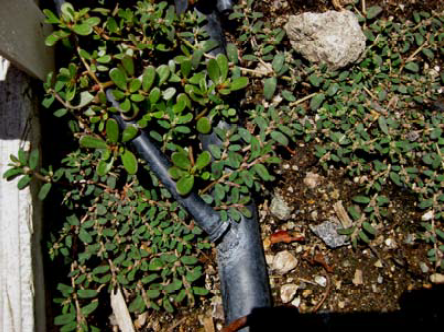
It’s not uncommon to see purslane growing with other weeds, such as spotted spurge (shown at right and lower left). Photo by S. Donaldson.
Life cycle
Summer annual (sprouts in spring and summer)
Reproduction
Reproduces by seed. One plant can produce 240,000 seeds.
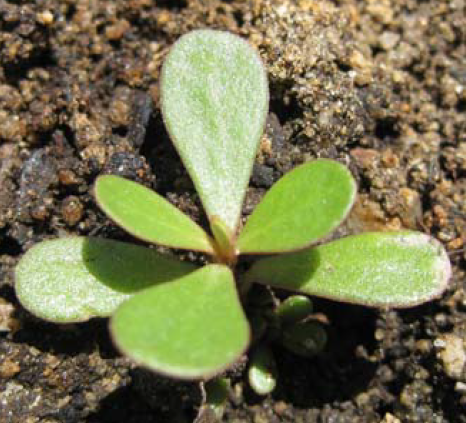
Seedlings have fleshy leaves. Photo by S. Donaldson.
Control methods
Once established, common purslane can be very difficult to control due to the large number of seeds produced, so preventing establishment of this weed is essential. Control should focus on removing seedlings before flowering occurs.
Mechanical
Dig, pull or hoe plants. The weed can reroot after cultivation, so it is essential to remove pulled material.
Cultural
Mulching with landscape fabric or 3 or more inches of organic mulch to exclude light can be effective. Soil solarization can help reduce the number of seeds in infested garden beds during hot summer months.
Biological
A sawfly eats the leaves of the plants, but has not provided good control in our region. Large amounts of purslane can be toxic to livestock and people.
Chemical
Spot‐treat seedlings or young plants with broadleaf‐selective herbicides. Use a surfactant according to label directions. Pre ‐emergent herbicides may be used to manage sites with many seeds.
References
- Cudney, D.W., C.L. Elmore and R.H. Molinar. 2007. Common Purslane Management Guide, UC IPM ANR Publication #7461, IPM.
- DiTomaso, J.M. and E.A. Healy. 2007. Weeds of California and Other Western States. University of California Publication 3488.
- Rumph, M. and M. Schat. 2009. HPIPM: Common Purslane. Center for Invasive Species and Ecosystem Health, U. of Georgia, Bugwood Wiki.
- Whitson, Tom D. (editor). 2002. Weeds of the West. University of Wyoming, Jackson, Wyoming.
Donaldson, S. and Hanson Mazet, W.
2010,
A Northern Nevada Homeowner’s Guide to Identifying and Managing Common Purslane,
Extension | University of Nevada, Reno, FS-10-26


